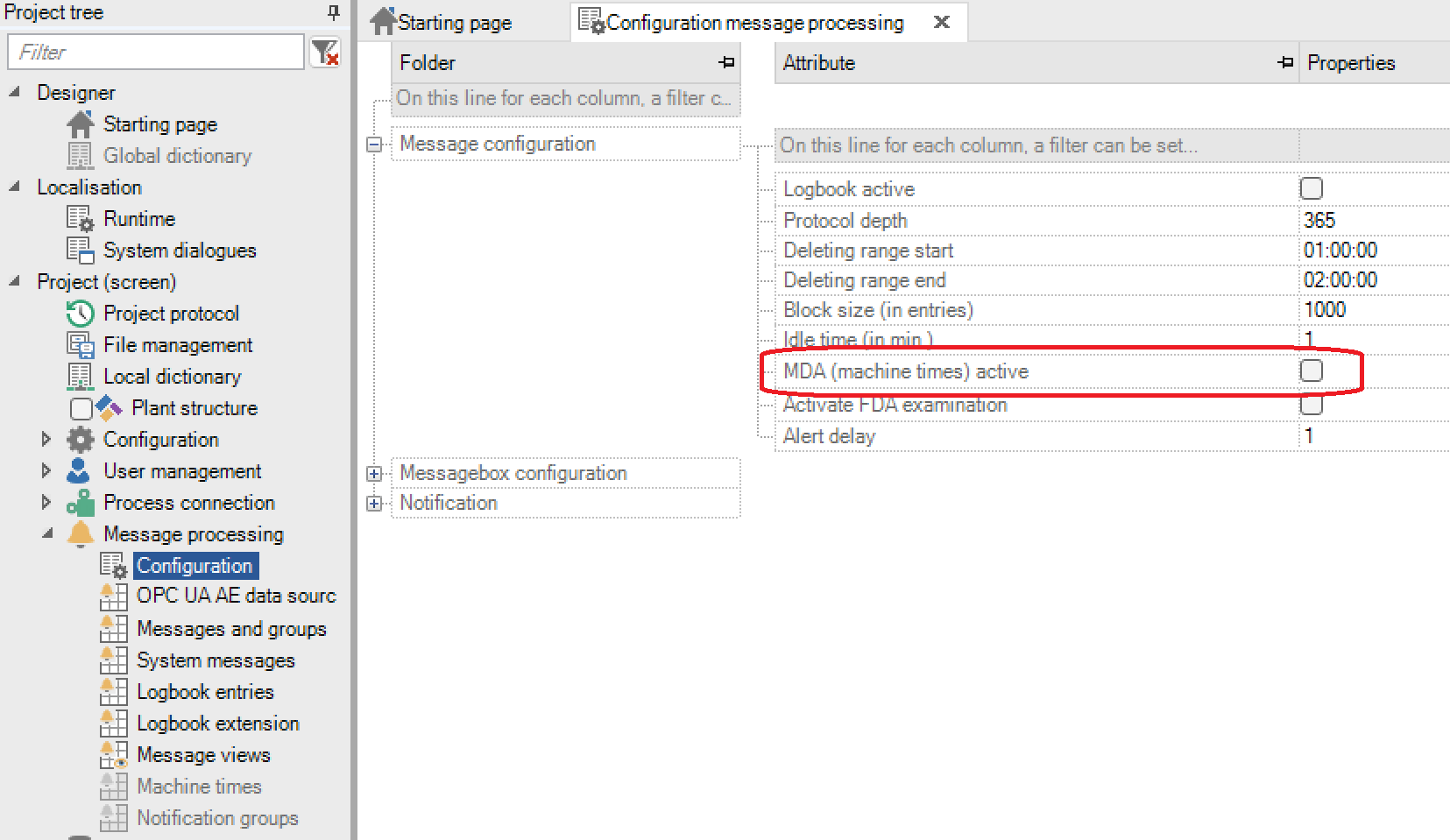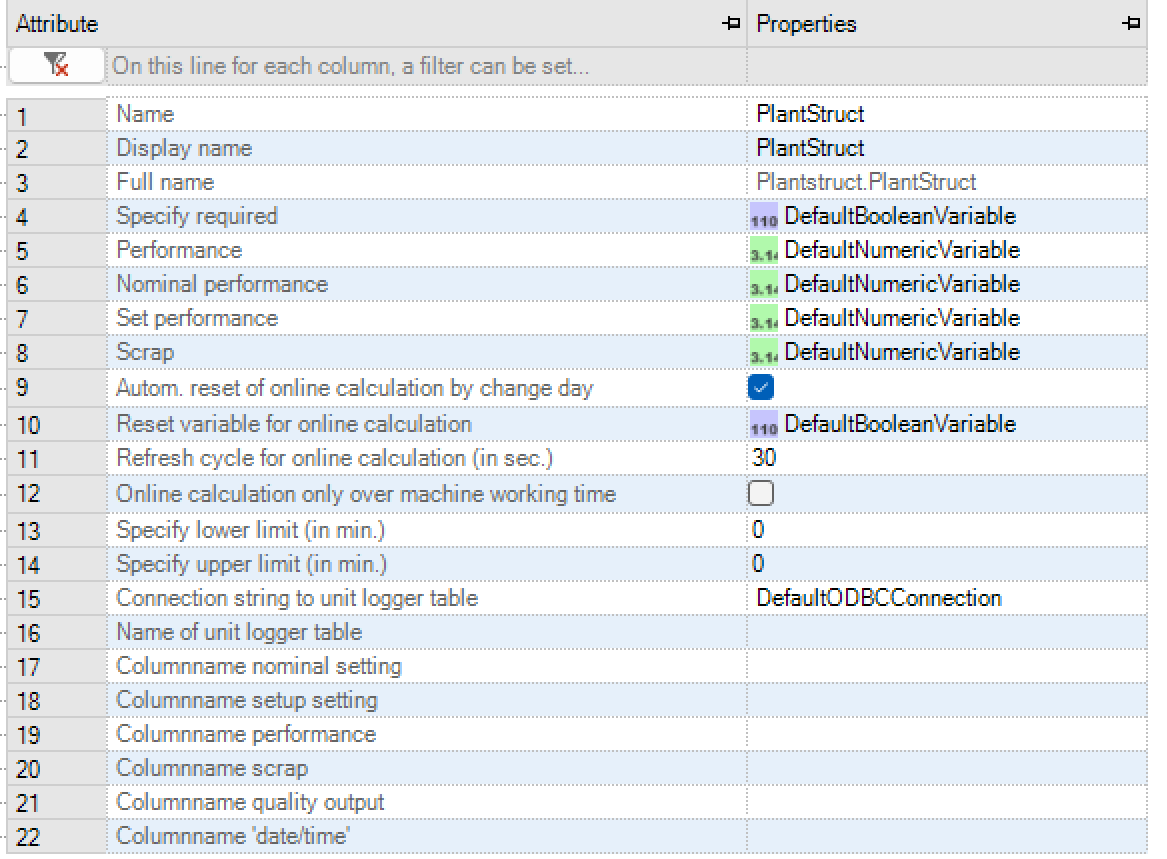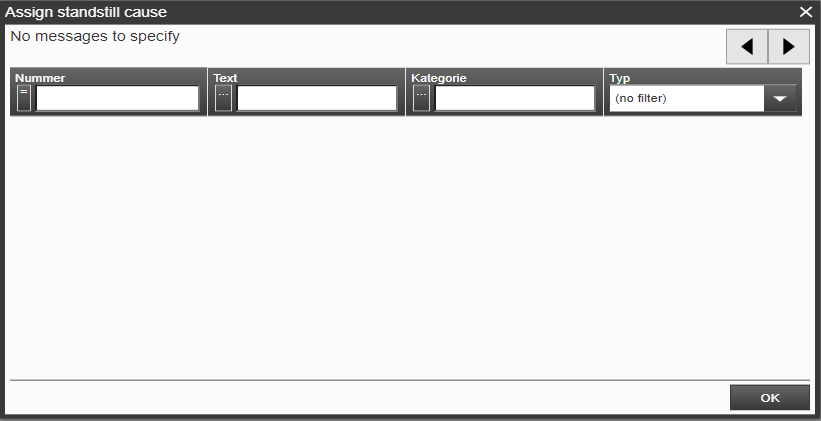Machine times (only SCADA)¶
General¶
In PROCON-WEB it is possible to have machine time key figures (KPI: Key Performance Indicator) calculated according to DIN 8743. The terminology and meaning of the key figures can be found in DIN 8743.To be able to use the machine time functionality, it is first necessary to activate it in the project. This is done via the configuration of the message processing.

General project planning¶
General parameteres¶
The KPIs are only calculated for one unit (machine) and over a certain period.For the evaluation, the system has to be supplied with certain parameters from “outside”. These are machine times and machine key figures.The machine times are mapped via alarms / messages and the key figures are either in an SQL logger table (calculation via script) or are represented by process variables.The following parameters are required:
Theoretically usable time tT (time domain specification via script or Automatic calculation for online evaluation)
Machine working time tW
Planned downtime tD
System-related, unplanned downtime tFS
Unplanned downtime tFE that is not system-related
Nominal output pn
Adjustment output ps
Application p
Committee pLQ
Machine times¶
Any number of different machine times can be created in the designer, but these must be assigned to a specific machine time type.

The following machine time types are available:
Machine working time
Planned downtime
Unplanned downtime (system-related)
Unplanned downtime (not system-related)
Project planning for online calculation¶
General online calculation¶
The theoretically usable time tT for the online calculation results from the start time of the alert service and the current time stamp. Depending on the setting, the calculation is reset, when the day changes or via a log. reset variable.The online calculation is configured individually for each unit:

Post-specification upper limit / Post-specification lower limit (in min.)¶
These two records can be used to define a time window for the subsequent specification, within which the subsequent specification of a message (standstill placeholder) is permitted.
Refresh cycle for online calculation (in seconds)¶
The online calculation is always carried out after a status change of an assigned machine time alarm and cyclically at a certain time interval (default: every 30 seconds).This time interval can be adjusted as required using this parameter. (Attention: system utilisation if the cycle time is set too low!).
Reset variable for online calculation¶
Logarithmic variable for resetting the online calculation.By setting the variable, the key figures are reset for the next online calculation and the start of the calculation is set to the current time stamp. The variable is set to 0 again after the reset.
Scrap / adjustment output / output / nominal output¶
Numerical variables that represent the key figures for nominal output pn, setting output ps, output p and scrap pLQ.
Online calculation only using machine working time¶
With this parameter, the theoretically usable time tT is set equal to the machine working time tW for the online calculation, so that the unused time ti is equal to 0.
Re-specifying necessary¶
Logical process variable for displaying the active window for subsequent specification, if defined, see also Post-specification upper limit / lower limit.
Autom. reset of the online calculation when the day changes¶
Automatic resetting of the online calculation when the day changes.By setting the variable, the key figures are reset for the next online calculation and the start of the calculation is set to the current time stamp.
Configuration for calculation via script function¶
Script function in general¶
The machine time calculation can also be initiated using a script function. This calculation takes place over a parameterisable period, and the result is stored in the database of the AlertService in the SQL server.Since the function works asynchronously, you have to wait in the script for the end of the calculation with status queries. A client cannot initiate any parallel calculations.With each new calculation, new entries are made in the result tables that are not deleted by the AlertService.
Description of the CalculateDIN8743 () script function¶
CalculateDIN8743: (int Aktion, string Auftrag, string AuftragID, string Unitname, real Start, real Ende, real Modus, real Gutteile, real Schlechtteile)
Action:
0 = start of calculation
1 = termination of the calculation
2 = progress query of the calculation
3 = status query of the calculation
The following parameters are only evaluated with action 0 (start of calculation):
Order, name of the order (user-defined text to identify the calculation)
OrderID, ID of the order (user-defined text to identify the calculation)
Unit name, unique name of the unit to be calculated (e.g. ‘Plant structure. Plant.Linie1.Unit1’)
Start, start time of the evaluation in seconds since 1970
End, end time of the evaluation in seconds since 1970
Mode, DIN calculation mode
0 = absolute time (end-start) as the basis for calculation
1 = machine working time tW as the basis for calculation
The last two parameters can be used to overwrite the number of good or bad parts from the logger table. Values> = 0 overwrite or replace the values determined from the logger table.
Good parts, number of good parts within the calculation period
Bad parts, number of bad parts within the calculation period
Return values for action status query:
-1 = Error
0 = OK or done
1 = Calculation is running
2 = Calculation canceled
Return values for action progress query:
-1 = Error or calculation aborted
0 – 100 = Fortschrittsangabe
Other return values:
-2 = unknown unit name
-3 = wrong calculation time parameters start and end
-4 = a calculation is currently being carried out
-5 = internal calculation error (wrong parameters in the unit definition, etc.)
-6 = AlertService is blocked now (e.g., online project update)
Required parameters from the unit definition¶
Additional machine parameters are required to calculate the machine key figures. These must be continuously logged in a database table.The information about the logger table is parameterised in the respective unit definition.If these are not available, only the machine times in the DINTimes table are calculated.

DINTimes result table¶
The calculated DIN times of a unit are stored in the DINTimes table.The entry consists of the unique unit name, the start and end time of the calculation and all DIN times in seconds, as a percentage of the total duration and as a duration string.

DINData result table¶
The calculated DIN parameters of a unit are stored in the DINData table.The entry consists of the unique unit name, the start and end time of the calculation and all DIN parameters.

Statistics calculation via script function¶
Scriptfunktion¶
The function is used to calculate statistics. All statistical values of a calculation with the user-defined identifiers are saved in a table and can then be filtered and read from there.With each new calculation, new entries are made in the result tables that are not deleted by the AlertService.
Description of the CalculateStatistic()¶
CalculateStatistic (int action, string order, string orderID, string country code, real start, real end)
Action:
0 = start of calculation
1 = termination of the calculation
2 = progress query of the calculation
3 = status query of the calculation
The following parameters are only evaluated with action 0 (start of calculation):
Order, name of the order (user-defined text to identify the calculation)
OrderID, ID of the order (user-defined text to identify the calculation)
Country code, desired language of the alarm texts in the results table (e.g. de-DE)
Start, start time of the statistics calculation in seconds. since 1970
End, end time of the statistics calculation in seconds. since 1970
Return values for action status query:
-1 = Error
0 = OK or done
1 = Calculation is running
2 = Calculation canceled
Return values for action progress query:
-1 = Error or calculation aborted
0 – 100 = Fortschrittsangabe
Other return values:
-3 = wrong calculation time parameters start and end
-4 = a calculation is currently being carried out
-5 = internal calculation error (wrong parameters in the unit definition, etc.)
-6 = AlertService is blocked now (e.g., online project update)
Results table statistik¶
The calculated statistical values of each alarm of an evaluation are stored with the transferred identifier (ID column) and the start and end time of the calculation.

Re-specify¶
Using the “Re-specify” function, messages that are marked as “Reason = to be allocated” in the Designer can be re-specified at runtime. Message definitions with “reason = selection” are required in the Designer. The real reasons for downtimes or other machine times can be selected afterwards for placeholders via the re-specify dialog.
Function description¶
The message to be specified is displayed in the “Assign cause of standstill” dialog. The buttons to the right of this can be used to switch between the messages to be specified, provided there are more than one. The message number, message text, period and tooltip are displayed.The corresponding reasons are shown in the table below. The displayed alarm can be specified by marking a reason and confirming with OK. Alternatively, you can re-specify the message by double-clicking on a reason. If there are no more messages, the dialog is automatically closed.

Operation of the features¶
Configuration of the message reason table¶
The table in the lower area of the re-specifying dialog can be configured via the message view “Default_Nach Specify_Ansicht”

You can choose which columns should be displayed, how they should be sorted and which colour definitions should be used.
Delay and fade out by time¶
The configuration of the unit contains the following entries, among others:

If a lower limit is set, the message will only be visible in the re-specify dialog after this has expired. If an upper limit is set, the message disappears as soon as it has expired.
Type pre-filter¶
If the assigned message has defined a machine time type, the list of reasons is automatically pre-filtered according to this.
Simultaneous operation on several terminals¶
If an alarm is re-specified, all opened re-specification dialogs are updated in order to avoid double specification. If a user specifies the last open message, all open dialogs close automatically.
